SETTING UP FOR COILING
This is the first of five pages that will tell you how to make springs. The information covered on this page is necessary, no matter what kind of spring you want to make.
The next pages, covering torsion springs, extension springs, compression springs, and finishing techniques, will round out the subject.
To get the most from these pages you should have your wire, your tools, and the design in mind for a spring you want to make. You should also print out this page and the page relating to the type of spring you want: that way you can get started right away.
(For info on coiling without a lead screw, see the section on compression springs.
The Arbor
Making springs by hand basically consists of bending wire around a rod called an arbor or mandrel. The arbor is secured in the chuck of a winding machine (typically either a drill, a hand winder, or a lathe). This section will tell you how to get the right diameter arbor, but it's also important to get the right length. Correct arbor length is important because it's difficult (not impossible, but difficult) to coil a spring on an arbor that's not long enough. Here's how to figure out how long your arbor has to be.
- Estimate the amount of arbor you'll need to accommodate the spring itself.
Know that spring wire wound on an arbor will take up more space than the same spring will after it's off the arbor. How much more depends on the number of coils and the size of the wire. Generally, the more coils in the spring, the more it will contract after coiling. Also generally, the smaller the wire, the more space it will take up on the arbor. And lastly, the larger the arbor, the more room you'll need to accommodate your spring while coiling. A couple of examples might help with all this:
A heavy torsion spring with 5 coils will generally not uncoil more than about 1/2 a coil after winding. Giving yourself as much slack as you can, your arbor might be 6-8" longer than the spring, plus whatever length you need to chuck it up. A similar torsion spring made from very light wire (same diameter arbor) will lose more coils, and take up more room on the arbor when coiling. Because it's short to begin with, though, the 6-8" addition to the arbor length should still be okay. A long extension spring (like on a screen door) should be wound on an arbor at least a foot longer than the spring itself, again plus whatever you need for the chuck.
Add in the amount of arbor you'll need to secure it safely in the chuck. Add in a fudge factor - 10% will do - just for the heck of it.
Remember that your arbor should be at least the length you figure out here: there's no real maximum length until your winding machine won't support the weight.
The First Coils
Once you have your arbor, make a few coils to check the diameter. How you do this depends on what kind of machine you're using to coil your wire.
If you're using a drill:
First, make sure that your drill is mounted solidly. Best bet is to mount it in a vise. DON'T TRY TO HOLD ONTO A DRILL THAT'S BEING USED TO COIL WIRE! Mount your drill so that if you're standing with the drill in front of your left shoulder, the top of the chuck spins away from you when you turn it on. Next, chuck up your arbor. The diameter of the arbor should be a little less than the inside diameter of the spring you want to make. Get a piece of wire maybe a couple of feet long. Cut it off from the coil and make a 90-degree bend in one end, giving you a dogleg end about an inch long. Put your wire guide onto the arbor. Hold it with your right hand and position it an inch or so away from the chuck. Stick the dogleg end of your wire between the two topmost jaws of the drill chuck. Shove it in as far as the bend in the wire. Bring the wire guide near enough for the wire to catch in the groove in the pin. Keep the wire guide away from the chuck. At this point, your setup should look something like this:
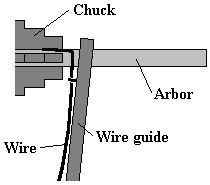
READ THIS STEP ALL THE WAY THROUGH BEFORE DOING IT!
When your setup is done, go ahead and turn on the drill. Keep the speed LOW, and keep your finger on the trigger. All you want to do is make a few coils, to check the diameter.
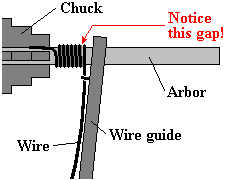 As the arbor starts to turn, two things will happen. The wire guide will "kick" upward: you can steady it with your right hand. It will also try to slide away to your right: let it slide for an inch or so, and then move your right hand to the left until the coils of wire lie flat against each other. What you're looking for is this: As the arbor starts to turn, two things will happen. The wire guide will "kick" upward: you can steady it with your right hand. It will also try to slide away to your right: let it slide for an inch or so, and then move your right hand to the left until the coils of wire lie flat against each other. What you're looking for is this:
Stop the drill before the "back" end of the wire reaches the pin in the wire guide. The gap in the diagram, by the way, is a good thing. If you see it while the coils are laying down, that means the coils will be tight up against each other when you're done. (In an extension spring, how tight the coils are is called "initial tension." There's more info on this on the extension spring page.) Reverse the drill SLOWLY until the coils hang free on the arbor. If you can't reverse the drill, you can grab the coils tight near the chuck and pull the dogleg out of the chuck. Loosen your grip on the coils slowly and let them unwind themselves until they're not under any tension. Then let go. Slide the wire guide and the coils off the arbor. Check the diameter of the coils and see how close you are to what you want. Remember, if you need an exact diameter, the size of the coil may change when you relieve the stress in the spring. See the page on finishing techniques for information on this. If the diameter is not what you want, go to a different size arbor, repeating steps 2-9 until the arbor is the right size.
That's it.
If you're using a hand winder:
First, make sure that your hand winder is mounted solidly. Mount it in a vise, or bolt it onto a workbench. Mount your hand winder so that the handle is to your left and the chuck is in front of your left shoulder. Next, chuck up your arbor. The diameter of the arbor should be a little less than the inside diameter of the spring you want to make. Get a piece of wire maybe a couple of feet long. Cut it off from the coil and make a 90-degree bend in one end, giving you a dogleg end about an inch long. Put your wire guide onto the arbor. Hold it with your right hand and position it an inch or so away from the chuck. Stick the dogleg end of your wire between the two topmost jaws of the drill chuck. Shove it in as far as the bend in the wire. Bring the wire guide near enough for the wire to catch in the groove in the pin. Keep the wire guide away from the chuck. At this point, your setup should look something like this:

When your setup is done, go ahead and start turning the handle. Turn it so that the TOP of the chuck moves AWAY from you.
 As the arbor starts to turn, two things will happen. The wire guide will press upward: you can steady it with your right hand. It will also try to slide away to your right: let it slide for an inch or so, and then move your right hand to the left until the coils of wire lie flat against each other. What you're looking for is this: As the arbor starts to turn, two things will happen. The wire guide will press upward: you can steady it with your right hand. It will also try to slide away to your right: let it slide for an inch or so, and then move your right hand to the left until the coils of wire lie flat against each other. What you're looking for is this:
Stop turning the handle when you have three or more complete coils side by side on the arbor.
The gap in the diagram, by the way, is a good thing. If you see it while the coils are laying down, that means the coils will be tight up against each other when you're done. (In an extension spring, how tight the coils are is called "initial tension". There's more info on this on the extension spring page.) Turn the handle the other way SLOWLY until the coils hang free on the arbor. Don't unwind so far that one of the jaws of the chuck catches the wire dogleg and starts to unwind the spring for you! Slide the wire guide and the coils off the arbor. Check the diameter of the coils and see how close you are to what you want. Remember, if you need an exact diameter, the size of the coil may change when you relieve the stress in the spring. See the page on finishing techniques for information on this. If the diameter is not what you want, change your arbor, repeating steps 2-9 until the spring is the right size.
That's it.
If you're using a lathe:
If this is the first time you're using the lathe, make sure you're familiar with it. Know how to stop the dang thing before you turn it on! Also, make sure you have a clear space around you (common sense). Next, chuck up your arbor. The diameter of the arbor should be a little less than the inside diameter of the spring you want to make. If you're using a four-jaw chuck, you'll have to center your arbor. Do this by turning on the lathe and holding a piece of chalk in your hand, right next to the tool post. Move your hand slowly towards the arbor until the chalk leaves a mark. Then, stop the lathe and adjust the jaws of the chuck so that the arbor moves away from the mark. Tighten the jaws and do this again, until the arbor is close to being centered (it doesn't have to be exact).
Next, back off one of the jaws of the chuck and put your pickup pin between the jaw and the arbor. Let it stick out past the end of the jaw about twice the diameter of the wire you'll be using (see the diagram below). What type of wire guide you use depends on how heavy your wire is. For medium and light wire, you can use the same type of guide as for a hand winder or drill: for heavy wire (over about ¼"), use a tool post-mounted wire guide. If you're using light wire, you can read the directions for this step as if you were using a hand winder (above). Otherwise, complete this step as below.
Put your wire guide into the tool post. It should be positioned just a little under the top of the arbor. With small wire, the distance between the arbor and the wire guide should be fairly close; for medium wire, 3-6"; for heavy wire, 6-12". The groove in your wire guide should also be fairly close to the tool post: the heavier the wire, the closer it should be. Cinch the wire guide down TIGHT.
This is what your setup should look like edge-on from where you're standing:
Note the horizontal clearance between the right end of the pickup pin and the left end of the wire guide. Get a piece of wire a few feet long (the heavier the wire, the longer the piece: also, the bigger the arbor, the longer the piece). Cut it off from the coil. Position the pickup pin of the lathe at the top of the chuck and thread your wire UNDER the wire guide, OVER the arbor, and UNDER the pickup pin. At this point, your setup should look something like this:
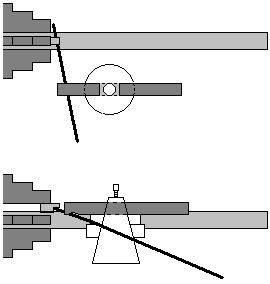
READ THIS STEP ALL THE WAY THROUGH BEFORE DOING IT!
Before you start the lathe, make sure you have one hand on the motor control and the other on the lead screw lever. (If you're coiling without a lead screw, see the section on compression springs on how to control the motion of the tool post as you coil.) Reach UNDER the wire with this hand, so that if the wire guide breaks, the wire will not snap upwards and catch you in the armpit.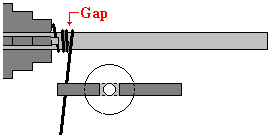
Start the lathe DEAD SLOW so that the TOP of the chuck moves AWAY from you. Keep the tool post steady and watch the "front" end of the wire as it comes around. It should clear the ways and the wire guide.
As the arbor starts to turn, the wire will close up on itself. Keep the tool post steady until a small gap appears in the coils, like this.
 When this gap appears, let the tool post move slowly to the right and continue coiling until you have about three full coils side by side on the arbor: When this gap appears, let the tool post move slowly to the right and continue coiling until you have about three full coils side by side on the arbor:
Stop the lathe and run it backwards SLOWLY until the coils hang free on the arbor. Don't let the "front" end of the wire catch on the jaws of the chuck as they come around. Slide the coils off the arbor and check the diameter to see how close you are to what you want. Remember, if you need an exact diameter, the size of the coil may change when you relieve the stress in the spring. See the page on finishing techniques for information on this. If the diameter is not what you want, change your arbor, repeating steps 2-9 until it's the right size.
That's it.
Left-Handed Springs
There's one more little oddity you should know about: torsion springs come left-handed and right-handed:
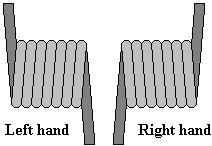
Depending on what you want your spring to do, you may need one or the other, or both. The setups described above tell you how to set up for a right-handed spring. If you want to make a left-handed spring, you'll need to make a left-handed setup because a right-handed setup will not work for a left-handed spring!
Left-Handed Spring Setup
Everything you read about setups for right-handed springs is exactly the same for left-handed springs, except for two things. When winding a left-handed spring:
- The wire will travel OVER the pin on the wire guide, UNDER the arbor, and OVER the pickup pin.
- The top of the chuck will be going TOWARD you as you make your coils.
The basic setup for a tool post-mounted wire guide will look like this:
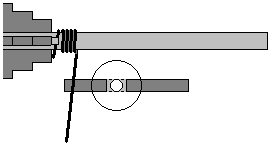
The only tooling modification you'll need is if you're using a hand-held wire guide: the guide pin will need to stick out in the opposite direction from what was shown above.
The only difference this will make is that your first coil count will be somewhat of a guess, because you won't be able to see when the gap passes bottom dead center of the arbor. On your second trial spring, though, you should be able to correct this exactly with your chalk mark.
Forward to torsion springs.
Forward to extension springs.
Forward to compression springs.
Terms of Use
|


 As the arbor starts to turn, two things will happen. The wire guide will "kick" upward: you can steady it with your right hand. It will also try to slide away to your right: let it slide for an inch or so, and then move your right hand to the left until the coils of wire lie flat against each other. What you're looking for is this:
As the arbor starts to turn, two things will happen. The wire guide will "kick" upward: you can steady it with your right hand. It will also try to slide away to your right: let it slide for an inch or so, and then move your right hand to the left until the coils of wire lie flat against each other. What you're looking for is this: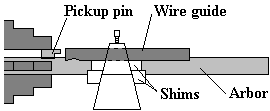


 When this gap appears, let the tool post move slowly to the right and continue coiling until you have about three full coils side by side on the arbor:
When this gap appears, let the tool post move slowly to the right and continue coiling until you have about three full coils side by side on the arbor:
